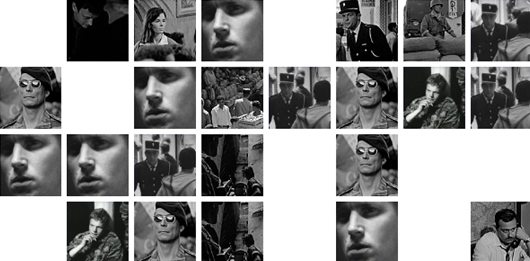The Battle of Algiers 2006
Marc Lafia and Fang-Yu Lin

The Battle of Algiers by Marc Lafia and Fang-Yu Lin consists of a continual re-composition of scenes from the seminal 1965 film of the same name, by Italian director Gillo Pontecorvo.
The original film proposes a re-enactment of historical events. The success of the actual battle for independence in Algiers has been attributed to the nationalists' organisation: a pyramidal structure of-self organised cells. Lafia and Lin's work uses computation to re-present the logic of the nationalists' tactics as depicted in Pontecorvo's film, by playing and sequencing clips along varied algorithmic trajectories.
… [Marc Lafia and Fang-Yu Lin’s] The Battle of Algiers de-emphasises the film's dramaturgic components, focusing on the film's modes of movement, its meanderings and collisions, its speeds and drifts, its points of intensity, its lines of force, its fluxes and flows. Thus The Battle of Algiers brings the [notion of a] database to the fore, articulating and amplifying the film's multiple trajectories.
Daniel Coffeen from Film, Play, Power and the Computational, or Byting Celluloid
Formally, the work breaks down cinema’s linear structure, proposing an open ended narrative in which the viewer’s intervention catalysts a set of events prescribed by pre-defined rules, which are based on the artists’ interpretation of the original work in combination with the inherent nature of its subject.
The Battle of Algiers has been commissioned in collaboration with artport, the Whitney Museum of American Art's portal to net art.
You will need Flash to view the project.
Marc Lafia InterviewMarc Lafia and Fang-Yu Lin interview - discussing their work, The Battle of Algiers
Film, Play, Power and the Computational, or Byting CelluloidDaniel Coffeen discusses Marc Lafia's and Fang-Yu Lin's The Battle of Algiers and the new context of non-linear cinema.
Also read / view
The DumpsterNet Art by Golan Levin in collaboration with Kamal Nigam and Jonathan Feinberg, also commissioned in conjunction with Artport, 2006
Screening CircleNet Art by Andy Deck, also commissioned in conjunction with Artport, 2006
Further References
Mark Lafia's websiteFang-Yu Lin's websiteArtportArtport is the Whitney Museum's portal to net art and digital arts, and an online gallery space for commissioned net art projects.
Node.LondonThis project launched in conjunction with Node.London, A season of networked, open and distributed events in London, 2006
Download Flash Player